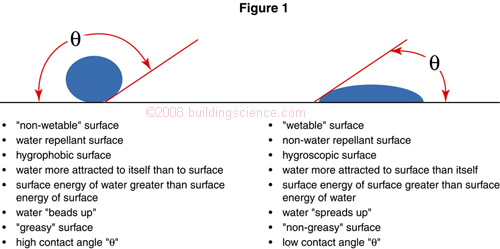The primary function of a housewrap or building paper is rain penetration control. It is not air infiltration despite what the manufacturers say. The energy aspects of housewraps are vastly overstated. They have been embraced by builders for this function as can be evidenced by their market penetration. Yet their critical role in building durability is under appreciated and not marketed. It has been a triumph of marketing over physics.
The primary function of a housewrap or building paper is rain penetration control. It is not air infiltration despite what the manufacturers say. The energy aspects of housewraps are vastly overstated. They have been embraced by builders for this
function as can be evidenced by their market penetration. Yet their critical role in building durability is under appreciated and not marketed. It has been a triumph of marketing over physics.
The problem with building papers in general and housewraps in particular is a loss of water repellency. Contaminants referred to as surfactants ("surface-active contaminants") either raise the surface energy of the housewrap or building paper or lower the surface energy of the water allowing the "wetting" of the housewrap or building paper surface by water. Once wetting of the housewrap or building paper surface occurs, material pores in the housewrap or building paper become filled allowing transport of liquid phase water across the housewrap or building paper via capillarity or hydrostatic pressure (gravity).
Figure 1 graphically illustrates some of the terms just used.
Water soluble extractives in wood such as tannins and wood sugars in redwood and cedar are a type of surfactant that contaminate the surface of housewraps and building papers raising their surface energy. Detergents and soaps are another type of surfactant that contaminate the surface of water lowing its surface energy. Both result in the liquid (in this instance "water") being able to "wet" the surface (in this case the building paper or housewrap). The surface energies of either the liquid or surface or both are altered so that the surface energy of the surface becomes greater than the surface energy of the liquid.
Back-priming or back-coating wood clapboards and trim helps to isolate the surfactants in the wood from the housewrap or building paper surface.
Similarly, providing an airspace between wood trim and clapboards using furring or some other spacer ("cedar-breather") reduces the quantity and time liquid phase water is trapped in the exterior of the wall assembly thereby reducing the potential of surfactant movement. Where wood is concerned, both back-priming and an airspace are highly recommended.
Where stucco is concerned, stucco should never be installed in direct contact with any of the plastic based housewraps. Stucco can "bond" or adhere to the housewrap surface altering its surface energy thereby allowing housewrap pores to become "wetted" and subsequently establish capillary flow. Another issue with stuccos is many stuccos have additives that improve workability and freeze-thaw resistance. These additives are typically surfactants.
A drainage space between stucco and building papers or housewraps is essential to control liquid phase water penetration. Bonding typically does not happen between stucco and building papers. However, with most stucco applications over building
papers insufficient drainage results. It is recommended to use at least two layers of building paper under stucco in order to allow some drainage between the two layers. Even better is to provide a spacer between the two layers of building paper by using a textured building paper or a building paper with granules or cork adhered to its surface thereby creating a space.
Another analogy that might be useful in understanding some of the concepts involved is one of being inside of a tent during a rainstorm and pushing your finger against the inside of the tent surface creating a leak by both compressing and tensioning the fabric altering its surface energy.
Dirt and dust can also affect housewrap performance. Think of a fabric that is "Scotch Guarded" to be water repellent that subsequently becomes dirty. The fabric must be cleaned to remove the contaminants and retreated to re-establish water repellency. Don't let your housewraps become muddy or dirty.
Yours truly,
Joseph Lstiburek, Ph.D., P. Eng.
"Rocket-Scientist"

